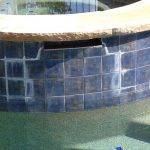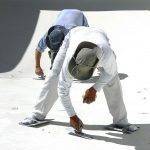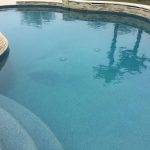The calcium saturation index, or CSI, is a measure of how over-saturated or under-saturated your water is with calcium carbonate. If your CSI is excessively positive (>0.6), there is a chance calcium scale could form under the right conditions. If your CSI is excessively negative (<-0.6), the water could dissolve calcium from your pool’s plaster and/or waterline grout. This phenomenon is usually referred to as etching, pitting, or erosion. This is not an overnight process and can take several months to occur.
TFP recommends maintaining CSI between -0.3 and 0.3 to allow for plenty of wiggle room.
How do I calculate my CSI? Very simple – by using our PoolMath tool. Since CSI is calculated by combining pH, TA, CH, and water temperature (among other items), simply enter your test results in PoolMath and refer to the CSI row. The tool will tell you if your water is balanced or if there is a potential for scale or erosion.
You should not focus on achieving a “perfect CSI” as no such number exists. Similarly, you should not stress if your CSI falls out of the “safe range” as it takes time for any problems to occur. Instead, focus on adhering to TFP recommended levels first. When conditions beyond your control (water temperature) cause the pool’s CSI to fall above/below the balanced range, use PoolMath to help correct CSI.
Pools with vinyl liners and most modern fiberglass pools contain no plaster that could erode, so excessively low CSI should not be a problem. However, scale formation is still a potential issue with these pools, and so all pool owners should attempt to keep their CSI between -0.6 and 0.6.
Use PoolMath to calculate your CSI level prior to closing your pool, as cold water temperature increases the risk of plaster damage during the winter. Typically, increasing your pH to 7.8-8.0 will keep your CSI balanced in spite of colder water temperatures.
There are some conditions that warrant monitoring your CSI when reviewing your numbers in the PoolMath tool:
– Pools that tend to have extremely hard water or excessively high alkalinity (potential for scale)
– Pools that tend to have naturally soft water or low alkalinity (potential for erosion – plaster pools only)
– Saltwater chlorine generator (SWG) owners (potential for scale on cell plates)
– Pools with waterline tile (potential for scale or erosion)
– Pools that have been recently plastered, especially those recently completed and closed before winter (potential for dramatic pH increases)
Again, for most pool owners, CSI should not be of concern. For those in the scenarios listed above, pool owners may benefit from learning more and monitoring their CSI. Practice with the PoolMath tool by changing the pH and other water test parameters so you can see how to manipulate CSI to your advantage. For example, those with SWGs and very hard water may elect to keep their CSI slightly negative (0.0 to -0.3) to help prevent scale build-up on SWG cell plates. In most cases, the adjustment of pH has the most dramatic effect on manipulating CSI, and pH is easiest to adjust.





